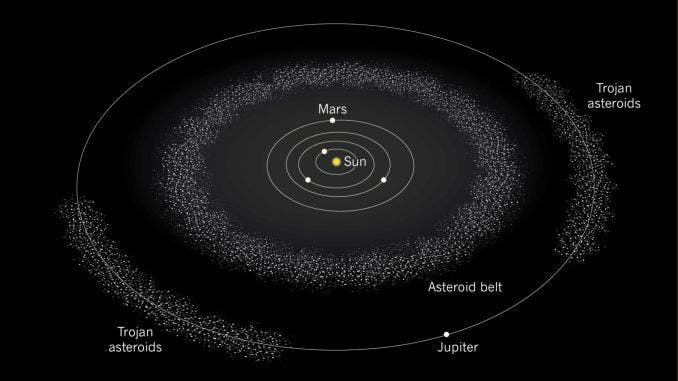A duo of French scientists at the Université de Bordeaux is proposing a radically different theory that explains the origin of the asteroid belt. According to their new model, the main asteroid belt that orbits between Mars and Jupiter could have formed from ejected material from various neighboring planets.
The main asteroid belt is a circumstellar disc in the solar system that draws an imaginary frontier between the rocky and gas planets. It’s comprised of billions (perhaps trillions) of asteroids and minor planets which lie more than two-and-a-half times as far as Earth does from the Sun.
You’ll sometimes see Hollywood movies show a stressed commander trying to navigate his spaceship through dangerously close asteroids. Inside our solar system at least, that’s a non-issue, as the asteroids are spaced too far apart to warrant a close call. From Voyager to the more recent New Horizons mission to Pluto, none of our spacecraft had any issue crossing the asteroid belt. According to NASA, the total mass of the belt is less than the moon, far too small to weigh in as a planet.
A different take on the birth of the asteroid belt
The currently accepted theory that explains the belt’s formation suggests that early in solar system’s history, some five million years after the sun formed, Jupiter and Saturn moved inward toward the sun before changing direction and heading back to the outer solar system, scattering the asteroid belt in the process.
It’s thought that about 99 percent of the original asteroid belt is now gone, flung away by Jupiter’s massive gravitational pull. The gravitational effect is also thought to prevent the material from coalescing into a large planet.
Sean Raymond, the lead author of the study and an astronomer at the University of Bourdeaux, has a different take on the matter. He and colleague Andrei Izidoro propose a new, very different explanation for the asteroid belt’s formation. According to their calculations, it’s quite possible that the asteroid belt was initially almost empty, but was only later filled with S – and p-type asteroids, which form the inner and outer edges of the belt, respectively.
Asteroids closer to the rocky planets, the S-type, most frequently contain silicate, just like the inner planet. C-type asteroids tend to contain more carbon, similarly to the gas giants. This distribution suggests the material these asteroids are made of comes from early planets. Essentially, the asteroids could be excess material that was ejected into the asteroid belt where it remains to this day.
To test these assumptions, the researchers built a model of the early solar system where the space occupied by today’s asteroid belt is empty. Running the model forward revealed that it is indeed possible, though not necessarily likely, that material from the outer planets contributed the material required for the belt, the authors reported in Science Advances.
Raymond and colleagues are now seeing to improve their model on the lookout for more tangible evidence that supports their view.










